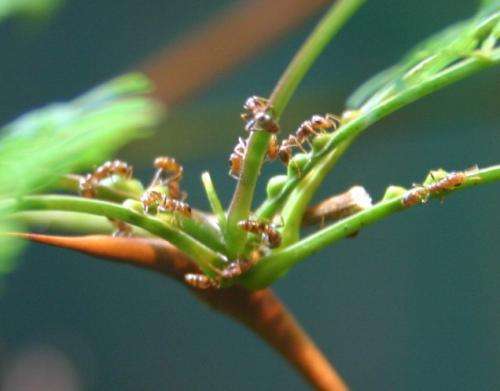February 2, 2017 report
Fussy ants found to improve chances of finding better new nesting sites

(Phys.org)—A team of researchers with the University of Bristol has found that differences in behavioral traits among ants help when it comes to finding a new nest—at least with rock ants. In their paper published in Proceedings of the Royal Society B, the team describes their study of ant behavior in artificial nests, the differences in behavior they found and how they appeared to help them establish a new nest.
Rock ants live in cracks between rocks, which puts them at some risk due to weather or other animals destroying their nests. When this occurs, they find a new one. However, the researchers with this new effort found that there was more to the decision-making process than previously thought.
To learn more about how the ants go about finding a site for a new nest, the researchers collected specimens of the ants and placed them into an artificial environment where they were kept alone and where possible nest sites were artificially created.
In studying the ant behavior, the researchers learned that ants have very particular rules when choosing a nest site—it had to have a ceiling height of approximately 2mm, a gap of 1.5mm at the entrance, low light, and the interior had to be approximately 20 square centimeters in size. To gauge the suitability of nest sites, the ants were given an opportunity to choose among several options, some of which very closely suited their needs and others that did not. In so doing, the researchers found that some ants were content to live in any of the nests they came upon (demonstrated by laying down and spreading pheromones) while others were much more demanding. The ants that were more demanding, the team noted, were the same ants that behaved in ways that suggested they were not happy with a nest once chosen.
In the wild, the researchers suggest, it is likely the fussy ants help the colony find a new nest because they would be more likely to visit more locations, ultimately leading to the best possible site. Still unclear, however, is the means by which different behavioral characteristics arise in different ants. The team plans to take a closer look to see if they can find the drivers for it.
More information: Thomas A. O'Shea-Wheller et al. Variability in individual assessment behaviour and its implications for collective decision-making, Proceedings of the Royal Society B: Biological Sciences (2017). DOI: 10.1098/rspb.2016.2237
Abstract
Self-organized systems of collective behaviour have been demonstrated in a number of group-living organisms. There is, however, less research relating to how variation in individual assessments may facilitate group decision-making. Here, we investigate this using the decentralized system of collective nest choice behaviour employed by the ant Temnothorax albipennis, combining experimental results with computational modelling. In experiments, isolated workers of this species were allowed to investigate new nest sites of differing quality, and it was found that for any given nest quality, there was wide variation among individuals in the durations that they spent within each nest site. Additionally, individual workers were consistent in spending more time in nest sites of higher quality, and less time in those of lower quality. Hence, the time spent in a new nest site must have included an assessment of nest quality. As nest site visit durations (henceforth termed assessment durations) are linked to recruitment, it is possible that the variability we observed may influence the collective decision-making process of colonies. Thus, we explored this further using a computational model of nest site selection, and found that heterogeneous nest assessments conferred a number of potential benefits. Furthermore, our experiments showed that nest quality assessments were flexible, being influenced by experience of prior options. Our findings help to elucidate the potential mechanisms underlying group behaviour, and highlight the importance of heterogeneity among individuals, rather than precise calibration, in shaping collective decision-making.
Journal information: Proceedings of the Royal Society B
© 2017 Phys.org



















